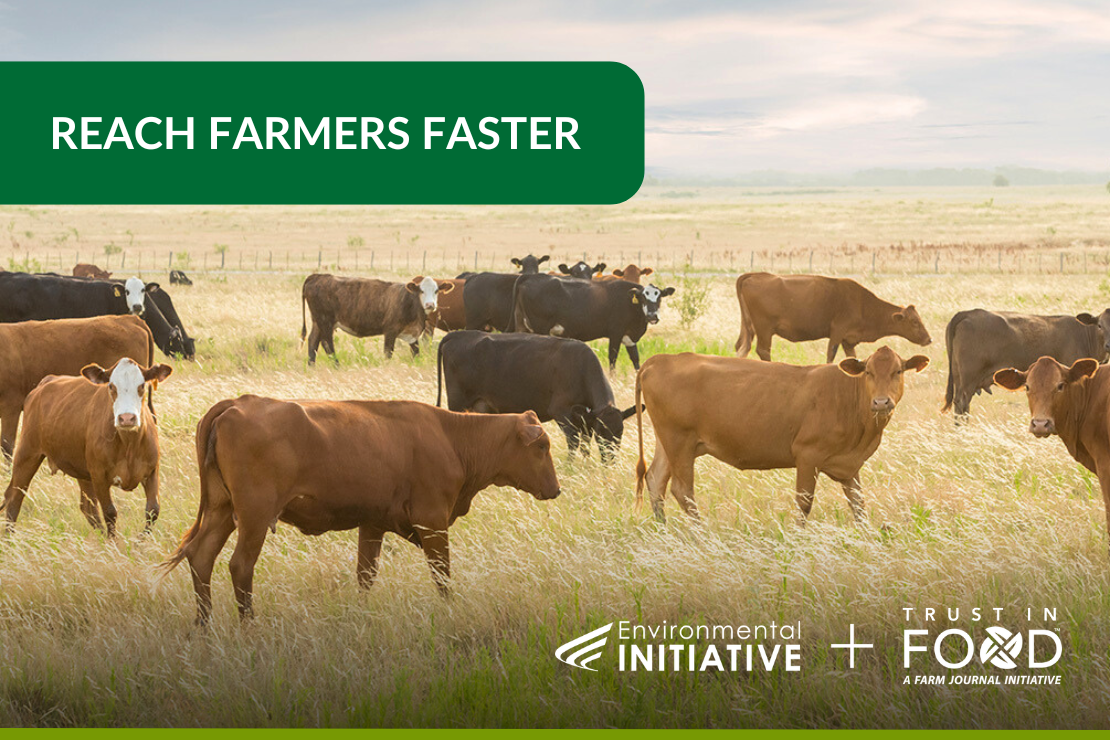Reaching Farmers Faster begins at the farm gate

Agricultural change is human change. Behind every agricultural shift or practice change, there lies a producer who is making decisions every day on behalf of the animals and acres they steward. Each one of those decisions comes with a variety of factors.
When considering conservation practice changes at the farm gate, there are two ends of a long path; on one end is a farmer or rancher, poised to make a change on-farm. On the other is the conservation community, which has tools and solutions designed to support that change.
An ongoing partnership between Environmental Initiative and Trust In Food™, the climate-smart agriculture arm of Farm Journal, is helping to shorten this distance by using data and intelligence to identify where producers are in their conservation journey and connect them with programs that meet their unique situations with actionable solutions.
We began this work from the shared understanding that to accomplish change, we must stop making broad presumptions and listen to and understand what producers are sharing.
“At Trust In Food, we believe that success in projects such as these is measured not in metrics, but in acres, farms, hearts, and minds that are more interested in conservation as a result of our work with leading organizations like Environmental Initiative,” said Amy Skoczlas Cole, President, Trust In Food.
The movable middle
There will always be farmers eager to test new practices and change the landscape—those are early adopters. But early adopters make up a small percentage of the whole. Most farmers seek substantial knowledge, navigate capacity shifts, and expect proof-of-value before acting on a new investment.
This curious, yet cautious group can be thought of as the “moveable middle.”
Our work begins with an in-depth understanding of the values of movable-middle producers—a process that provides insight into how and why farmers and ranchers are motivated to change, what guides their decisions, and what barriers or obstacles might inhibit them. Knowing this information helps outreach professionals partner with producers to add value to their operations and reach conservation goals more quickly.
Our data-informed process
Trust In Food utilizes data and insights to identify and assess a key audience through demographics, geography, and operation type. The propriety tool known as the “Sustainability Readiness Index” dives deep into leading indicators of change and takes into consideration, among other things, a farmer’s approach to sustainability, decision-making practices, technical support, operational elements, and vision for the future of their operation.
In the Sustainability Readiness Index, operations are scaled on their conservation journey into the following dimensions:
- Understanding – Agronomic, soil health, animal handling, and ecological principles.
- Value – Added value from conservation agriculture to support an operation’s goals.
- Feeling Capable – Perceived barriers and support needed to execute change.
- Trigger for Action – Trusted sources of information and influence.
Using this tool allows organizations to develop outreach and technical support designed to resonate with producers’ interests and expertise.
For example, in our first project with Environmental Initiative, we were most interested in providing resources to moveable-middle row crop producers who were open to new practices but had not yet undertaken change. We evaluated 500+ data points from 50,000 producers and supplemented our findings with quantitative research to pinpoint their key values and decision-drivers.
While we used Farm Journal’s behavioral and psychographic insights to ensure our work was aligned with producer wants and needs, similar information can be gathered from a variety of sources. Organizations may explore their own data, organizational memberships, the U.S. Census, the USDA Census of Agriculture, and state or county agriculture/property data for local insights to build upon. Focus groups, field day surveys, and input from trusted advisors could also serve as starting points.
The key is activating data to provide a holistic picture of the producers your organization wants to reach. Pulling from a wide array of sources, including stakeholders who work alongside farmers, agriculture extension services, or local agronomic organizations and industry experts, is a powerful way to validate or provide perspective to your findings.
Understanding the movable middle
Identifying a geographic and demographic group to support is not enough to create impact. Applying the Sustainability Readiness Index to the movable-middle row crop producers in our work with Environmental Initiative, we identified patterns that led us to explore the following value sets:
- Leadership – this group values their role as leaders in their operations and communities, allowing them to make decisions about their own land and its future.
- Protection – we found that this group is interested in tactics that help me protect their land, operations and values, including high yields, regulation and risk management.
- Legacy – passing the farm down to the next generation in their family is critical to this group of producers.
Data and analysis were translated into a persona who represented an important segment of producers we hoped to reach with robust engagement.
Repeating the model for ranchers
In continued work between Trust In Food and Environmental Initiative, a refined model of using data-informed insights to understand farmers and how they make decisions is being applied to ranchers as we move into the Northern Great Plains with a 12-month outreach effort.
This analysis will be added as a case study to the Reach Farmers Faster online tool in early 2026. We are committed to the platform reflecting a wider spectrum of American agriculturists.
Connect with us
Contact Deborah Carter McCoy or Jamie Sears Rawlings to learn more about this exciting project. For more insight on upcoming opportunities, sign up for the Environmental Initiative newsletter or follow us on LinkedIn.